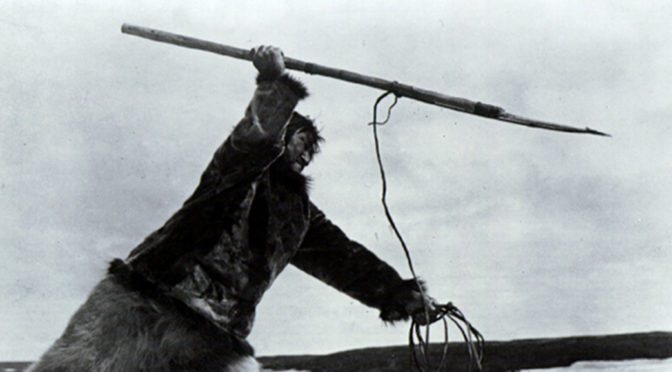Robert Flaherty’s 1922 film NANOOK OF THE NORTH is considered by most film historians to be the medium’s first ever feature-length documentary. Filmed on Canada’s Hudson Bay, within the Arctic Circle, this uniquely expressive ethnographic work follows the eponymous Inuit master hunter and his family.
Flaherty’s episodically-structured account of their nomadic existence and daily struggle for survival highlights encounters with other human inhabitants and various wildlife, along with the specific tasks necessary to brave the harshest of environments. Nanook’s fishing in a wandering ice field, harpooning a walrus, and tugging a massive seal to the frozen surface are all depicted in vivid detail. But the film’s true centerpiece is a sequence devoted to the building of an igloo. In a triumph of early cross-cutting, Flaherty seamlessly collapses an hour-long step-by-step process into less than ten minutes of screen time, all the while underscoring the family’s collective effort to sustain life, by using the natural elements at their immediate disposal.
Flaherty infuses Nanook of the North with both an explorer’s sense of sweeping adventure and a deep melancholy (at the very start, the viewer is informed that Nanook died a year after filming was completed). The threat of starvation amidst this desolate landscape is a constant that looms large over every image, down to the film’s haunting final frame. Flaherty’s aesthetic, which he would later refine on the masterworks MAN OF ARAN (1934) and LOUISIANA STORY (1948), relies on a fusion of non-fiction and fiction filmmaking techniques, a deceptively simple interplay between captured reality and staged reality. His work, in other words, is far removed from the dogmatic constraints of cinema vérité, and, instead, focused on capturing the poetic spirit of his subjects. In this way, his films are the cinematic precursor to the non-fiction work of Werner Herzog. Unfortunately, in recent years, so many other filmmakers have degraded the documentary form, preferring to use it as a mere vehicle for the dispersion of raw information and shallow ideologies. Even today, the pioneering experience of NANOOK OF THE NORTH, one of the genuine treasures of the silent era, reaffirms that a documentary could potentially be a beautiful, humanistic, and timeless work of art.


One thought on “Nanook of the North”
Comments are closed.